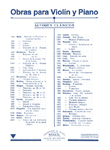Sonata
Violín y Piano
GRANADOS, EnricReg.: B.3535
21,00 €
P.V.P. (VAT included 4%)
Add to cart
- Review: McCLURE, Mac
- Ensemble: Duos: With piano.
- Genres: Classical / contemporary: Chamber.
- Product format: Partitura + particellas
- Difficulty level: Advanced-superior
- Period: Romanticism
- Publishing house: Editorial Boileau
- Collection: Siglo XXI
- No. of pages: 44+12
- Measure: 31,00 x 23,00 cm
- Lenght: 16'07"
- ISMN: 979-0-3503-3669-0
- Available in digital: No
- Available for rent: No
The chamber music repertoire by Enrique Granados has not received the attention that it deserves for many years. A great part of his works for chamber ensembles is still unpublished today and the few existing editions are hardly faithful to the original manuscripts. This situation has caused his violin and piano works to be the least known of his compositions with the exception of his choral or orchestral works. This publication hopes to change this situation. Based on manuscripts in the collections of the Music Museum of Barcelona and the National Library of Catalunya we have created two volumes which include almost all his music for violin and piano. One of his shortest works, and that which is included here, is the Sonata for Violin and Piano.
It is necessary to explain that this work was published many years ago as a single movement composition. However, there is a manuscript with a complete second movement and sketches for an incomplete fourth movement. The third movement has been lost. There are several manuscripts of unfinished works for piano and violin that are in forms such as «Adagio», «Romanza» o «Andante» but none have any reference to the Sonata so until something else is found or re discovered we must consider the third movement lost.
This edition presents the first two movements, both dedicated to the French violinist Jacques Thibaud (1880-1953). The manuscript is not dated. However, since the earliest known performance given by the composer and violinist was in November, 1908 we can deduce that the work was written after that time.
The musical language of the first movement is somewhere between the Romantic tradition of the 19th Century and French music of the early 20th Century. There are certain points in common with the music of Fauré, which is not surprising since Granados studied with Charles de Bériot and was a close friend of Ricardo Viñes, one of the most famous pianists of the fin de siècle musical world. The work incorporates modal harmonies which are combined with tonal and chromatic elements, seventh and ninth chords as well as a highly personal use of augmented chords. Melodically the violin part is based on the opening theme, which is introduced in the fifth measure. Throughout the first movement the various musical ideas use this phrase as a reference point.
The second movement is titled Scherzo in the complete manuscript although in the manuscript of the violin part there is also another title—«Intermedio». The form is a classic scherzo in ternary form: ABA without a coda. Stylistically the first part of this movement continues the language of arpeggios and scales used in the second theme of the first movement. The middle section has a character that alters between being at times “popular” and other times archaic, including medieval echoes which recall Granados’ opera Follet.
The piano part is very readable and the sections that have been crossed out coincide with the violin part. The violin part is a final copy in ink, that seems to have been prepared for performance or at least it is in excellent condition to be performed. Although there are several measures that Granados crossed out in the piano part, there are no doubts to the notes in the manuscript and the fact that there is a final violin copy in ink leads us to believe that this was a final thought on what this movement should be.
The fact that the Granados family archive was divided in an arbitrary manner between the collections of the Music Museum, the National Library of Catalunya and the now closed Center for Musical Documentation of the Generalitat could be the reason why no one realized that the Sonata was conceived in four movements and that the second movement had been completed (although it was difficult to read). The manuscript of this movement is preserved in the Music Museum with the Catalogue number 02.1389.
I. Lentamente con molta fantasia II. Scherzo (Allegro)








